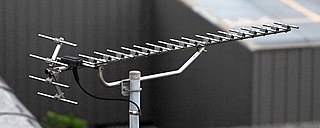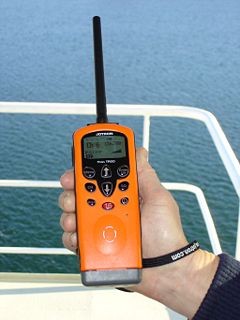
Wireless broadband is telecommunications technology that provides high-speed wireless Internet access or computer networking access over a wide area. The term comprises both fixed and mobile broadband.

IEEE 802.11 is part of the IEEE 802 set of local area network (LAN) technical standards, and specifies the set of media access control (MAC) and physical layer (PHY) protocols for implementing wireless local area network (WLAN) computer communication. The standard and amendments provide the basis for wireless network products using the Wi-Fi brand and are the world's most widely used wireless computer networking standards. IEEE 802.11 is used in most home and office networks to allow laptops, printers, smartphones, and other devices to communicate with each other and access the Internet without connecting wires.

A wireless network is a computer network that uses wireless data connections between network nodes.

Wi-Fi is a family of wireless network protocols, based on the IEEE 802.11 family of standards, which are commonly used for local area networking of devices and Internet access, allowing nearby digital devices to exchange data by radio waves. These are the most widely used computer networks in the world, used globally in home and small office networks to link desktop and laptop computers, tablet computers, smartphones, smart TVs, printers, and smart speakers together and to a wireless router to connect them to the Internet, and in wireless access points in public places like coffee shops, hotels, libraries and airports to provide the public Internet access for mobile devices.

Ultra high frequency (UHF) is the ITU designation for radio frequencies in the range between 300 megahertz (MHz) and 3 gigahertz (GHz), also known as the decimetre band as the wavelengths range from one meter to one tenth of a meter. Radio waves with frequencies above the UHF band fall into the super-high frequency (SHF) or microwave frequency range. Lower frequency signals fall into the VHF or lower bands. UHF radio waves propagate mainly by line of sight; they are blocked by hills and large buildings although the transmission through building walls is strong enough for indoor reception. They are used for television broadcasting, cell phones, satellite communication including GPS, personal radio services including Wi-Fi and Bluetooth, walkie-talkies, cordless phones, and numerous other applications.

Wireless communication is the transfer of information between two or more points that do not use an electrical conductor as a medium for the transfer. The most common wireless technologies use radio waves. With radio waves, intended distances can be short, such as a few meters for Bluetooth or as far as millions of kilometers for deep-space radio communications. It encompasses various types of fixed, mobile, and portable applications, including two-way radios, cellular telephones, personal digital assistants (PDAs), and wireless networking. Other examples of applications of radio wireless technology include GPS units, garage door openers, wireless computer mouse, keyboards and headsets, headphones, radio receivers, satellite television, broadcast television and cordless telephones. Somewhat less common methods of achieving wireless communications include the use of other electromagnetic wireless technologies, such as light, magnetic, or electric fields or the use of sound.

In computer networking, a wireless access point (WAP), or more generally just access point (AP), is a networking hardware device that allows other Wi-Fi devices to connect to a wired network. As a standalone device, the AP may have a wired connection to a router, but, in a wireless router, it can also be an integral component of the router itself. An AP is differentiated from a hotspot which is a physical location where Wi-Fi access is available.

A wireless Internet service provider (WISP) is an Internet service provider with a network based on wireless networking. Technology may include commonplace Wi-Fi wireless mesh networking, or proprietary equipment designed to operate over open 900 MHz, 2.4 GHz, 4.9, 5, 24, and 60 GHz bands or licensed frequencies in the UHF band, LMDS, and other bands from 6 GHz to 80 GHz.

Worldwide Interoperability for Microwave Access (WiMAX) is a family of wireless broadband communication standards based on the IEEE 802.16 set of standards, which provide physical layer (PHY) and media access control (MAC) options.
The S band is a designation by the Institute of Electrical and Electronics Engineers (IEEE) for a part of the microwave band of the electromagnetic spectrum covering frequencies from 2 to 4 gigahertz (GHz). Thus it crosses the conventional boundary between the UHF and SHF bands at 3.0 GHz. The S band is used by airport surveillance radar for air traffic control, weather radar, surface ship radar, and some communications satellites, especially those used by NASA to communicate with the Space Shuttle and the International Space Station. The 10 cm radar short-band ranges roughly from 1.55 to 5.2 GHz. The S band also contains the 2.4–2.483 GHz ISM band, widely used for low power unlicensed microwave devices such as cordless phones, wireless headphones (Bluetooth), wireless networking (WiFi), garage door openers, keyless vehicle locks, baby monitors as well as for medical diathermy machines and microwave ovens. India's regional satellite navigation network (IRNSS) broadcasts on 2.483778 to 2.500278 GHz.
The V band ("vee-band") is a standard designation by the Institute of Electrical and Electronics Engineers (IEEE) for a band of frequencies in the microwave portion of the electromagnetic spectrum ranging from 40 to 75 gigahertz (GHz). The V band is not heavily used, except for millimeter wave radar research and other kinds of scientific research. It should not be confused with the 600–1000 MHz range of Band V of the UHF frequency range.

HomeRF was a wireless networking specification for home devices. It was developed in 1998 by the Home Radio Frequency Working Group, a consortium of mobile wireless companies that included Proxim Wireless, Intel, Siemens AG, Motorola, Philips and more than 100 other companies.

The Nintendo Wi-Fi USB Connector is a wireless game adapter, developed by Nintendo and Buffalo Technology. which allows Nintendo DSi and Wii users without a Wi-Fi connection or compatible Wi-Fi network to establish one via a broadband-connected PC. Inserted into the host PC's USB port, the connector functions with the Nintendo DS. Wii, and DSi, permitting the user to connect to the Internet to play Nintendo Wi-Fi Connection games and access various other online services. The product was the best selling Nintendo accessory to date, according to the official Nintendo site on 15 November 2007 but it was discontinued in the same month until further notice. On September 8, 2008, Nintendo announced the Nintendo Wi-Fi Network Adapter, an 802.11g wireless router/bridge which serves a similar purpose.
Long-range Wi-Fi is used for low-cost, unregulated point-to-point computer network connections, as an alternative to other fixed wireless, cellular networks or satellite Internet access.
In telecommunications, white spaces refer to radio frequencies allocated to a broadcasting service but not used locally. National and international bodies assign frequencies for specific uses and, in most cases, license the rights to broadcast over these frequencies. This frequency allocation process creates a bandplan which for technical reasons assigns white space between used radio bands or channels to avoid interference. In this case, while the frequencies are unused, they have been specifically assigned for a purpose, such as a guard band. Most commonly however, these white spaces exist naturally between used channels, since assigning nearby transmissions to immediately adjacent channels will cause destructive interference to both.
Towerstream Corporation is a Fixed Wireless Fiber Alternative company delivering high-speed Internet access to businesses. The company offers broadband services in 12 urban markets including New York City, Boston, Los Angeles, Chicago, Philadelphia, the San Francisco Bay area, Miami, Seattle, Dallas-Fort Worth, Houston, Las Vegas-Reno, and the greater Providence area, where the company is headquartered. In 2014, Towerstream launched its On-Net fixed-wireless service offering On-Net building tenants access to dedicated, symmetrical high-speed Internet connectivity, with a premier SLA, at market-setting prices. Founded in 1999 by Philip Urso and Jeffrey Thompson (eFortress), Towerstream held its first public offering in January 2007 and traded on the NASDAQ Capital Markets under symbol TWER. In 2016 the stock had declined in price, was delisted from NASDAQ, and moved to the over-the-counter market.
Super Wi-Fi refers to IEEE 802.11g/n/ac/ax wifi implementations over unlicensed 2.4 and 5 GHz Wi-Fi bands but with performance enhancements for antenna control, multiple path beam selection, advance control for best path, and applied intelligence for load balancing giving it bi-directional connectivity range for standard wifi enabled devices over distances of up to 1,700 meters. Hong Kong-based Altai Technologies developed and patented Super Wi-Fi technology and manufacturers a product line of base stations and access points deployed extensively around the world beginning in 2007. Due to its extended range and advanced interference mitigation, Super Wi-Fi is primarily used for expansive outdoor and heavy industrial use cases. Krysp Wireless, LLC is Altai Technologies' Master Distributor for North America focused on the sale and distribution of Super Wi-Fi products for large enterprises, WISPs and municipal deployments. Altai's Super Wi-Fi technology should not be confused with the FCC's use of the term relating to proposed plans announced in 2012 for using TV white space spectrum to support delivery of long range internet access.
Li-Fi is a wireless communication technology which utilizes light to transmit data and position between devices. The term was first introduced by Harald Haas during a 2011 TEDGlobal talk in Edinburgh.
IEEE 802.11af, also referred to as White-Fi and Super Wi-Fi, is a wireless computer networking standard in the 802.11 family, that allows wireless local area network (WLAN) operation in TV white space spectrum in the VHF and UHF bands between 54 and 790 MHz. The standard was approved in February 2014. Cognitive radio technology is used to transmit on unused portions of TV channel band allocations, with the standard taking measures to limit interference for primary users, such as analog TV, digital TV, and wireless microphones.

Victor Bahl is an American computer scientist at Microsoft Research in Redmond, Washington. He is known for his research contributions to white space radio data networks, radio signal-strength based indoor positioning systems, multi-radio wireless systems, wireless network virtualization, and for bringing wireless links into the datacenter. He is also known for his leadership of the mobile computing community as the co-founder of the ACM Special Interest Group on Mobility of Systems, Users, Data, and Computing (SIGMOBILE). He is the founder of international conference on Mobile Systems, Applications, and Services Conference (MobiSys), and the founder of ACM Mobile Computing and Communications Review, a quarterly scientific journal that publishes peer-reviewed technical papers, opinion columns, and news stories related to wireless communications and mobility. Bahl has received important awards; delivered dozens of keynotes and plenary talks at conferences and workshops; delivered over six dozen distinguished seminars at universities; written over hundred papers with more than 25,000 citations and awarded over 100 US and international patents. He is a Fellow of the Association for Computing Machinery, IEEE, and American Association for the Advancement of Science.












